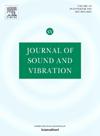超材料减振性能预测:一种处理参数不确定性的有效计算方法
IF 4.3
2区 工程技术
Q1 ACOUSTICS
引用次数: 0
摘要
机械超材料已被证明在减振方面很有用。然而,制造过程中的不确定性会影响其预期性能,因为每个子结构都会偏离标称特性。为了解释这一点,必须在结构层面进行不确定性量化,这可能涉及重大的计算成本。在本研究中,开发了一种新的计算框架来加速模型参数不确定性下超材料的减振性能识别。不确定性量化是基于蒙特卡罗模拟(MCS)在结构层面,允许每个单元格有独立的模型参数,避免了无限周期格的假设。通过采用Craig-Bampton (CB)模式综合、刚度矩阵摄动和Kriging代理模型的新颖集成,避免了MCS要求的高保真仿真递归计算的计算过载。该方法将超材料同时划分为小的子结构,在子结构水平上进行质量和刚度矩阵的模态缩减。摄动策略施加在基线模型上,并应用于每个子结构cb -减刚度矩阵。克里格模型为预测一组新模型参数的扰动大小提供了一个近似方法。通过三个算例说明了该方法的准确性和可实现性。这些结果展示了如何以更低的计算成本实现超材料的不确定性减振性能预测,从而允许在可处理的速度下对超材料进行不确定性量化分析。本文章由计算机程序翻译,如有差异,请以英文原文为准。
Vibration attenuation performance prediction in metamaterials: An efficient computational approach addressing parametric uncertainties
Mechanical metamaterials have proven useful for vibration attenuation applications. Nevertheless, uncertainties during the manufacturing process affect their expected performance as each substructure deviates from the nominal characteristics. To account for this, uncertainty quantification at the structural level must be performed, potentially involving a significant computational cost. In this study, a novel computational framework is developed to accelerate the vibration attenuation performance identification in metamaterials under uncertainties associated with model parameters. The uncertainty quantification is based on Monte Carlo Simulations (MCS) at the structure level, allowing each unit cell to have independent model parameters and avoiding the assumption of infinite periodic lattices. The computational overload of the recursive computation of high-fidelity simulations demanded by the MCS is avoided by the novel integration of a Craig–Bampton (CB) mode synthesis, stiffness matrix perturbations, and a Kriging surrogate model. The CB method partitions the metamaterial into small substructures simultaneously to perform a modal reduction of the mass and stiffness matrices at the substructural level. The perturbation strategy is imposed over a baseline model and is applied to each substructural CB-reduced stiffness matrix. The Kriging model provides an approximation to predict the perturbation magnitude for a new set of model parameters. Three example problems are developed to illustrate the accuracy and implementation of the method. These results showcase how the uncertain vibration attenuation performance predictions of the metamaterial can be achieved at a reduced computational cost, allowing for uncertainty quantification analysis of metamaterials at tractable speeds.
求助全文
通过发布文献求助,成功后即可免费获取论文全文。
去求助
来源期刊

Journal of Sound and Vibration
工程技术-工程:机械
CiteScore
9.10
自引率
10.60%
发文量
551
审稿时长
69 days
期刊介绍:
The Journal of Sound and Vibration (JSV) is an independent journal devoted to the prompt publication of original papers, both theoretical and experimental, that provide new information on any aspect of sound or vibration. There is an emphasis on fundamental work that has potential for practical application.
JSV was founded and operates on the premise that the subject of sound and vibration requires a journal that publishes papers of a high technical standard across the various subdisciplines, thus facilitating awareness of techniques and discoveries in one area that may be applicable in others.
 求助内容:
求助内容: 应助结果提醒方式:
应助结果提醒方式:


